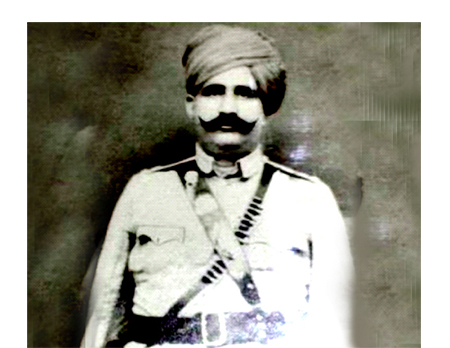
Veer Narayan Singh, a landlord hailing from Sonakhan in Chhattisgarh, played a crucial role in leading the 1857 war of Independence. He was martyred at Jaistambh Chowk in Raipur, Chhattisgarh, and is now recognised as the first freedom fighter from Chhattisgarh. Veer Narayan Singh’s forefathers belonged to the Gond tribe and lived in Sarangarh before switching their allegiance to the Binjhwar tribe and settling in Sonakhan, Raipur district.
His great-grandfather was Deewan of Sonakhan, and at the age 35, he took over the land lordship rights from his father Ram Rai.
Veer Narayan Singh fed the famine affected families by arranging grains and distributed it to the needy.
In 1856 when Chhattisgarh was in the grip of severe famine, the merchants hoarded grain. Veer Narayan Singh could not tolerate seeing people die of starvation. He sought to borrow grain from merchants as ‘Barhi‘.“He asked the merchants and lords to open the godowns and let the poor eat.” Like in so many famines, the granaries were full. He said that when the first crop came, people would replace the grain they were given. But merchants refused.
Ultimately, performing the duties of a Kshetra Pramukh , he arranged to take out grain from the warehouse and distribute it amongst the people, under intimation to Charles Elliot, the Deputy Commissioner of Raipur. Historians say, “A famine persisted for three consecutive years starting from 1856, causing both humans and animals to suffer greatly and resulting in a grain shortage. In this context, Narayan Singh took it upon himself to loot the grain from a grain store and distribute it among the villagers.
Narayan Singh led the frners to break the lock of businessman who had hoarded the grains
One prominent businessman in the Sonakhan area at the time was named Makhan and had a substantial supply of grain. However, when farmers approached him for grain on loan during the famine, Makhan refused to comply with their request. Subsequently, the villagers sought the help of Narayan Singh, who led them in breaking the locks of Makhan’s grain store and distributing the grain to the villagers.”
In 1856 when Chhattisgarh was in the grip of severe famine, the merchants hoarded grain. Veer Narayan Singh could not tolerate seeing people die of starvation. He sought to borrow grain from merchants as ‘Barhi‘.“He asked the merchants and lords to open the godowns and let the poor eat
British sent foprces to apprehend Narayan Singh
Makhan complained to his British master. The Commissioner filed charges of theft and dacoity against Narayan Singh, but it was only a matter of time before the British would apprehend him. With the aid of Raja Surendrasai of Sambalpur, the peasants managed to rescue Narayan Singh from Raipur jail. However, this act infuriated the British rulers, and they dispatched a large Army to capture Narayan Singh. In Sonakhan, Narayan Singh had formed his Army to resist the British. Consisting of 900 soldiers his Army was prepared to retaliate against the English forces.
Narayan Singh betrayed by his own people who sided with the British
Regrettably, the landlord of Deori, who was considered Narayan Singh’s uncle, openly supported the British, which ultimately led to Smith’s Army surrounding Sonakhan and succeeding in capturing Narayan Singh after a prolonged battle. Thus on the complaint of Makhan, a merchant, the British Government arrested Narayan Singh on October 24, 1856 at Sambalpur and sent him to jail at Raipur.
In 1857 when the flame of revolution was ignited in the country, it lit sparks in the forest region of Chhattisgarh. The people unanimously elected the imprisoned Narayan Singh as their leader. With the help of soldiers and the public, Narayan Singh escaped from jail in August 1857 and reached Sonakhan. He organised his trusted followers and formed an Army of 500 men. Under the leadership of Smith, an influential British Army was dispatched to crush the Sonakhan Army. He had an encounter with the British Army near Sonakhan. The atrocities and the acts of devastation and destruction by the British moved him. Except for Surendra Sai, the landlord of Sambalpur, all the zamindars supported the British and betrayed Narayan Singh.
Narayan Singh surrenders to the British to save lives of his own people
He surrendered himself to the British Army to protect the people’s lives. Subsequently, on December 10, 1857, the British publicly hanged Narayan Singh at Jai Stambh Chowk in Raipur before the ordinary people. However, despite his execution, Narayan Singh’s courage shattered the British aspirations of dominating Chhattisgarh. The people fiercely protested the British Army, leading to a spirit of rebellion against the British among the general public. Following these events, the British Army was effectively challenged and ultimately expelled from the land of Chhattisgarh.
Veer Narayan Singh’s martyrdom did not go in vain
The Army contingent stationed at Raipur and the public revolted at Raipur on January 18, 1858 under the leadership of Hanuman Singh. A British officer was killed. People were inspired by the immortal sacrifice of Narayan Singh, and 17 of them were sentenced to death on January 22, 1858. Their sacrifice, like Veer Narayan Singh’s martyrdom, was a memorable event in the history of Chhattisgarh, giving momentum to the freedom movement. A postal stamp in honour of Veer Narayan Singh was issued in 1987 by the Government
of India.
Leave a Comment